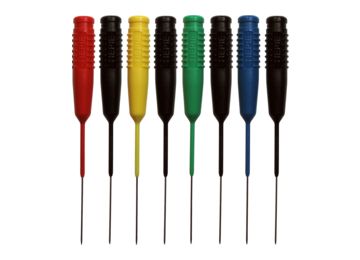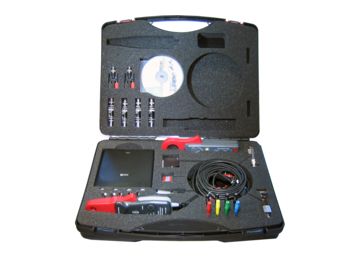Sensor information
| Type: | Hot wire with frequency output |
|---|---|
| Power supply: | 12 V |
| Signal type: | Frequency varying |
| Signal level: | 0.2 V to 5 V or 12 V (battery voltage) |
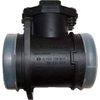
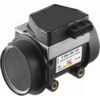
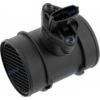
Workings of the hot wire mass air flow sensor with frequency output
The hot wire air intake sensor with frequency output measures the amount of air going into the engine in the same way as the normal hot wire mass air flow sensor. The difference between the sensors is found in the output signal: the sensor in this article has a frequency changing output. The frequency changes according to the amount of air passing the sensor. A low frequency corresponds to a low air flow, a high frequency corresponds to a high air flow.
Connecting the lab scope
Correct functioning of the hot wire air mass sensor sensor with frequency output can be checked by measuring the following signal voltages, see figure 1:
| Channel | Probe | Voltage | Range |
|---|---|---|---|
| 1 |  |
Sensor output signal | 20 V |
 |
Ground on battery | ||
| 2 |  |
Positive side of sensor power supply | 20 V |
 |
Negative side of sensor power supply |
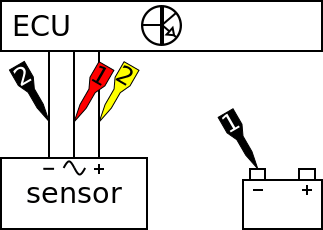
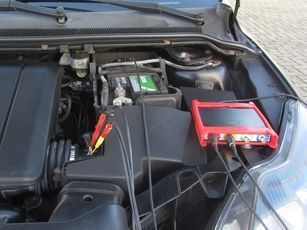
The lab scope is connected to the hot wire mass air flow sensor with frequency output via a Measure lead TP-C1812B and Back Probe TP-BP85 and is set to recorder mode.
In recorder mode a streaming measurement is performed, continuously displaying the signals live on screen. Because the measured signals vary slowly, the Automotive Test Scope ATS5004D is set to a slow measuring speed.
Measuring
Figure 3 shows a waveform of a hot wire mass air flow sensor sensor with frequency output. The signals are measured under the following conditions: key on, cranking, idle, 2000 RPM, 3000 RPM and back to idle again with the engine at operating temperature. This signal can be downloaded and used to correctly set up the lab scope or as reference signal.
Download hot wire sensor with frequency output measurement
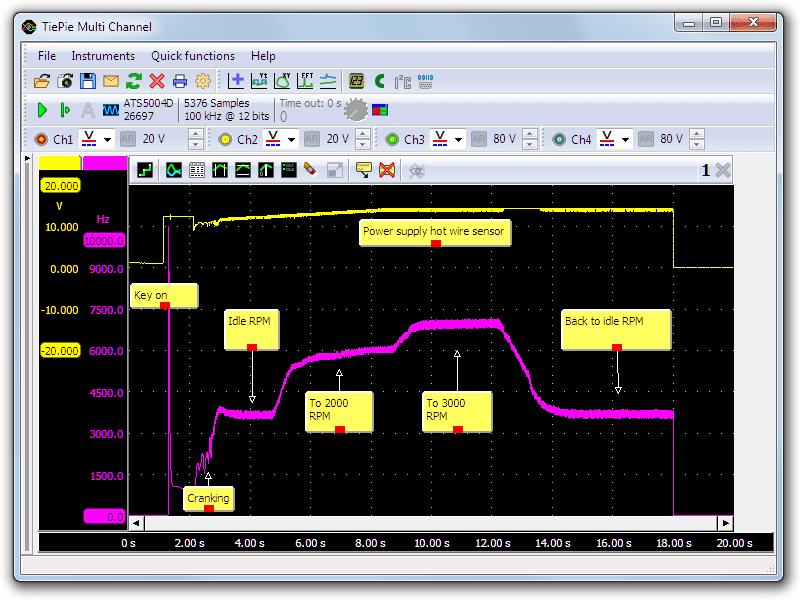
In figure 3, the sensor output signal on channel 1 is converted to a frequency signal (purple signal) by using an RPM I/O and channel 2 (yellow) shows the power supply of the hot wire mass air flow sensor. After the measurement is started, the key is switched on which powers the sensor. While the sensor is warming up the hot wire, the frequency momentarily spikes. When the engine is started a drop in the power supply is visible along the individual intake strokes in the frequency signal. When the engine has started and stabilized to idle speed the frequency is stable around 3660 Hz. The throttle is pushed to reach 2000 RPM and 3000 PRM after which the throttle is released to let the engine reach its idling RPM again. With the raising and falling air flow the frequency changes accordingly which is visible in the frequency signal.
Diagnosis
Signal values may differ on different types of engine control units and hot wire mass air flow sensors with frequency output. Consult ATIS for information on specific engine control units and hot wire mass air flow sensors with frequency output.
The following signal deviations can indicate a problem:
-
No signal:
Cause: back probes have no connection (perform a connection test), poor or no power supply to sensor, sensor defective
RELATED PRODUCTS
RELATED ARTICLES
- Mass Air Flow (MAF) hot wire sensor
- With a lab scope a Mass Air Flow (MAF) sensor is measured under the following conditions: key on, cranking, idle, 2000 RPM, 3000 RPM and back to idle with an engine at operating temperature. The signal from the sensor is shown and can be downloaded. To help determining whether a MAF sensor is functioning correctly, different possible deviations from the example signal are mentioned along with probable causes.
- Troublesome Volvo XC70
- A Volvo XC70 had serious engine related drivability problems. The engine lacked power, would hold back and even stall. Error codes indicated problems in two different areas. Replacing components did not improve things. Proper measuring with an automotive diagnostic oscilloscope revealed two independent problems. Fixing these solved all problems.
This document is subject to changes without notification. All rights reserved.
The information in this application note is carefully checked and is considered to be reliable, however TiePie engineering assumes no responsibility for any inaccuracies.
Safety warning:
- Before measuring, check that sources of dangerously high voltages are switched off or shielded from contact. Voltages considered to be dangerous are voltages over 30 V AC RMS, 42 V AC peak or 60 V DC.
- Keep a clean working environment when doing measurements.
- This measurement and procedures are a examples / measuring suggestions and are no prescribed protocols.
- TiePie engineering can not anticipate the safety actions that need to be taken to protect persons and appliances. Before starting a measurement, check which safety measures need to be applied.


